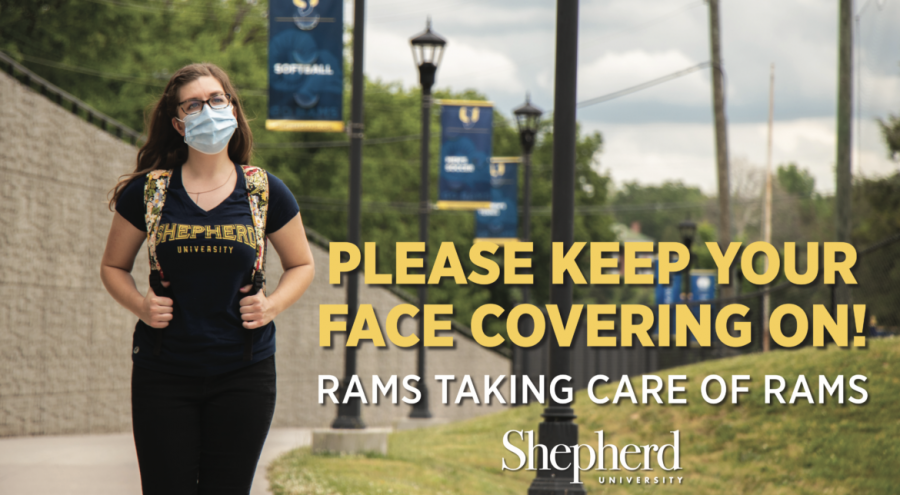The Shepherd University campus reconvened for in-person classes on August 23, 2021, for the first time since early last year.
On March 18, 2020, Shepherd University President Mary J.C. Hendrix announced that the remaining Spring semester would take place online due to the growing COVID-19 pandemic.
Over the next year and a half COVID-19 cases in the United States would rise to over 40 million, more than 650,000 of which would result in death.
As worry grew and economies suffered, voices from around the country commented on the profound human toll. Vijay Prashad, executive director of the Tricontinental, and former MIT professor Noam Chomsky named 2020 a period of “criminal incompetence by governments” as deaths ballooned. New York Times writer Alex Williams noted it was “the year of blur… a dream state, or a nightmare.”
In such a state of unpredictability, how well was the Shepherd campus community able to cope?
Assistant Professor of Social Work Amy Garzón-Hampton said she missed the human experience of being present with her students.
“So much of what we do in social work is about being in a space with people, being embodied with our students. It was sometimes a challenge.”
She added, “It’s a more genuine experience to be present with another person in their environment, but we couldn’t do that safely.”
Concerns over safety, uncertainty and protocol affected staff as well. Mary Valentine-Boutté, manager of the Shepherd University IT Services desk, felt worried: “It was scary. Not knowing what to expect was a strain, so that added to the stress. One of the biggest things that amazed me about COVID, though, was that you were able to see the true side of people. When people are in crisis, that is when you get to see the strength and resilience in them. I was scared, though.”
However, with the help of Laura Renninger, former dean of the Scarborough Library and Emily Gross, director of Academic Support, she mitigated some concerns by preparing the library for clean, socially distanced customer technology services. Directional arrows and distancing notices were placed on the floor. Hand sanitizer and cleansing wipes were given to employees. Tables were removed to allow as much space as possible for social distancing.
“I think we did very well for having to produce ideas on how to stay safer. The students did exceptionally well with the transition. We were all dedicated to each other and the campus community.”
The new routine grew easier for faculty and staff as the year went on. Yet, as vaccination rates stagnated around 53% and new COVID-19 variants appeared, certainty wavered once more.
“I was concerned the IT team would have to touch others’ belongings. I know some faculty were reluctant to come back after working from home. With the variant, our numbers are getting close to where the peak was. In some places I know they are. But it is good that we know more, so we can prepare. I know the students are glad to be back. The students have been great,” said Ms. Valentine-Boutté.
Professor Garzón-Hampton echoed these sentiments.
“My students have been so respectful. It opened empathy in them.”
A Facilities worker who spoke on condition of anonymity was concerned about safety as well as the larger economic meaning behind coming back to campus.
“The return of university life during another wave of COVID-19 cases is a frightening proposition. Shepherd, as a state university, is obviously in a stronger position but is not immune to the realities of the economic impact of the pandemic. Because in the current structure of our system of economics, capitalism, there is no other choice within it but to sacrifice our safety and health to continue to work. I must work to survive even though it is dangerous and avoidable because I will starve if I don’t.”
Amber Legowik is an English Literature major worried that the proximity to her peers may be a danger.
“Classrooms are filled at capacity again, which means practicing any sort of social distancing is impossible. I live in a small house with a severely handicapped person who does not have a normal immune system, so if I catch COVID-19 at school, which is the only place I spend enough time with other people to potentially get infected, it will be nearly impossible to protect the people I live with,” she said. “Before, we had the benefits of class time without breathing the same air as our classmates.”
Hesitance and enthusiasm play a dual role as campus life reemerges, each at diverse levels for different people. Sidewalks and hallways stir with masked students in route to classes and meetings, and professors confer over coffee about research and department decisions. Facilities workers ensure campus is sanitary, landscaped, and operational for all to use efficiently.
With the Delta variant forcing school closures in parts of the country, Shepherd University waits to see what the rest of the semester will bring
